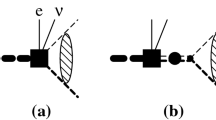Abstract
Linear response theory is used to investigate the collective excitation spectra of the outer shells of heavy atoms. A model, based on the approximate separability of particle-hole interaction matrix elements, is solved in closed form and found to be in semi-quantitative agreement with experiment for the vibrations of the 4d shell in Xenon. The separability of these matrix elements in the relevant energy region is shown to be due to a general property of wave functions of atomic potentials. A comparison is also made with full random phase approximation calculations for Xe. It is shown that the schematic model contains all the relevant features to describe the enhanced photo-absorption of this system in the far ultraviolet. The role of anf-wave resonance in the average atomic field is stressed in connection with this enhancement. Detailed agreement between the schematic model and experiment is less good than that obtained from the full random phase calculation, the differences arising due to an approximate treatment of exchange in the former calculation. The total dipole strength in the photo-electric region is approximately the same for both calculations however and in reasonable accord with experiment.
Similar content being viewed by others
References
Haensel, R., Keitel, G., Schreiber, P., Kunz, C.: Phys. Rev.188, 1375 (1969)
El-Sherbini, Th.M., Van der Wiel, W.J.: Physica62, 119 (1972)
Connerade, J.P., Mansfield, M.W.D.: Proc. Roy. Soc. (London) A341, 267 (1974)
Wendin, G.: J. Phys. B.6, 42 (1973)
Amus'ya, M.Ya., Ivanov, V.K., Cherepkov, N.A., Chernyshova, L.V.: Sov. Phys. JETP39, 752 (1974)
Wendin, G.: Phys. Lett.51 A, 291 (1975)
Brown, G.E.: Unified Theory of Nuclear Models and Forces, 2nd ed., Amsterdam: North-Holland 1967
Fano, U.: Phys. Rev.124, 1866 (1961)
Cooper, J.W.: Phys. Rev. Lett.13, 762 (1964)
Griffin, D.C., Andrew, K.L.: Phys. Rev.177, 62 (1969)
See for example Fetter, A.L., Walecka, J.D.: Quantum Theory of Many-Particle Systems. New York: McGraw-Hill 1971
Dover, C.B., Lemmer, R.H., Hahne, F.J.W.: Ann. Phys.70, 458 (1972)
Edmonds, A.R.: Angular Momentum in Quantum Mechanics, 2nd ed., Princeton: Princeton University Press 1960
Slater, J.C.: Quantum Theory of Matter, 2nd ed., New York: McGraw-Hill 1968
Froese-Fischer, C.: Some Hartree-Fock Results for the atoms Helium to Radon (Department of Mathematics, University of British Columbia, Vancouver, 1968)
Bethe, H.A., Salpeter, E.E.: Quantum Mechanics of one- and two-electron Atoms. Berlin-Göttingen-Heidelberg: Springer 1957
Pines, D., Nozières, P.: The Theory of Quantum Liquids. New York: W.A. Benjamin 1966
See for example Spicer, B.M.: Advances in Physics2, 1 (1969)
Author information
Authors and Affiliations
Additional information
One of us (F.J.K.) wishes to thank the Council for Scientific and Industrial Research for financial assistance during the course of the research reported in this paper.
Rights and permissions
About this article
Cite this article
Kok, F.J., Lemmer, R.H. Collective effects in atoms via a schematic model. Z Physik A 285, 339–346 (1978). https://doi.org/10.1007/BF01813232
Received:
Issue Date:
DOI: https://doi.org/10.1007/BF01813232




